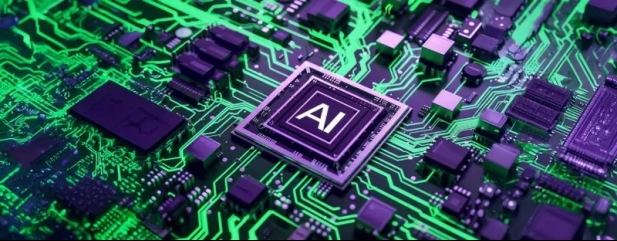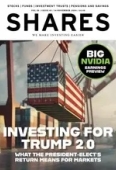Archived article
Please note that tax, investment, pension and ISA rules can change and the information and any views contained in this article may now be inaccurate.
What the market will be watching when Nvidia reports

In early September, shares in Nvidia (NVDA:NASDAQ) tanked. In just eight days, more than $400 billion of market cap vanished, leaving investors wondering what to do. To help, Shares took an in-depth look at the AI (artificial intelligence) chip designer and concluded that investors’ best bet was probably to do nothing.
Since then, the stock has rallied hard, adding more than $1 trillion to its market cap (now $3.65 trillion). Just consider that fact for a moment… $1 trillion added. That’s the equivalent of slapping a 2018-sized Apple (AAPL:NASDAQ) on to Nvidia’s market value.
That 45% run since early September 2024 saw Nvidia’s share price hit a new all-time high of $148.88 (7 Nov), powering the company beyond Apple and Microsoft (MSFT:NASDAQ) to become the world’s most valuable company. And by some margin - $200 billion more than Apple and nearly half a trillion dollars more than Microsoft, now numbers two and three respectively.
Right now, it seems no matter what the market throws at Nvidia, the stock just keeps going up.
A few days from now (20 November) will be the next potential catalyst as the Santa Clara, California-based business reports its fiscal third quarter. The numbers and commentary will shed more light on the firm’s growth trajectory and put its valuation into context.
As any decent fund manager will tell you, valuation is always important and a crucial part of any decision an investor should make about any stock. So, let’s look at Nvidia’s current valuation and scope to keep knocking the lights out.
WHAT DOES THE MARKET EXPECT?
According to Koyfin’s consensus data, the market anticipates EPS (earnings per share) of $0.74 on $32.9 billion revenue, or in other words, more than 80% year-on-year growth. Analysts see $0.81 EPS on $36.5 billion revenue in the last quarter to 31 January 2025.
For the full year, consensus implies 120% and 106% year-on-year growth in earnings and revenues respectively. If analysts are right, fiscal 2026 will see both metrics rally more than 40% again. As most readers will know, the stock has responded with gusto, up more than 200% this year and soaring from below $7 just before the pandemic broke.
Nvidia's consensus forecasts
The obvious conclusion is that Nvidia valuation multiples must be sky high today. But are they? Current consensus implies that the stock is trading on a PE (price to earnings) of about 43, based on a next 12-months basis. Yet, as the chart shows, the valuation is barely any higher today that it was back in 2020.
This is not quite the conundrum it may seem. It is a response to forecasts that since the start of 2023 have been raised again and again, and yet Nvidia has continued to beat them all, doing so for seven quarters straight as the scale of the AI (artificial intelligence) opportunity has emerged.
Forecasts have seen big upgrades
Looking at forecasts from roughly a year ago (see chart) gives an indication of just how AI has tilted the markets expectations for Nvidia’s earnings and revenue growth.
And you can see how optimistic this has made analysts by looking at how consensus price targets have soared, from around $60 roughly a year ago to more than $150 now. In January 2023, the consensus target price was pitched at $20.
WHY THE MARKET IS UPBEAT
Unlike other stocks that have surged this year, on AI excitement or otherwise, Palantir (PLTR:NYSE) say, or MicroStrategy (MSTR:NSASDAQ), few analysts are raising valuation questions about Nvidia, illustrated by how many have buy recommendations on the stock.
Japanese bank Mizuho this month named Nvidia its top pick, stressing the company’s strong chip leadership in AI and data centre markets, where it is estimated to command a 95% market share or more.
Mizuho anticipates substantial growth in the data centre AI chip market, projecting a compound annual growth rate of 74%, potentially pushing the market size past $400 billion by 2027. This expansion is expected to be driven by Nvidia’s advanced product line-up and roadmap in HBM, or high band-width memory chips.
Bernstein’s team believes that ‘several’ billion dollars of incremental Blackwell revenue into Q4 ‘should drive solid further sequential growth, and it feels to us that Hopper could easily continue to show sequential strength as well which might further accelerate things’.
Blackwell and Hopper are Nvidia’s next two generations of GPU (graphics processing units) earmarked for AI’s next development phase.
Then there’s Nvidia’s Grace CPU and NVL36/72 servers, which are seen as catalysts for content growth within AI servers.
But Nvidia remains a key player outside of AI and data centres, with its conventional clout in the gaming market. Here it holds an estimated 75% market share in PC gaming GPUs (graphics processing units). Mizuho analysts see untapped growth potential, noting their belief that ‘headwinds from China AI chip restrictions remain muted’.
OPPORTUNITIES BEYOND AI
The firm also points to an upgrade cycle opportunity with the upcoming RTX 50-series, given that penetration of the RTX 40-series stands at around 10% of the PC market, which could position Nvidia to reach a gaming revenue run rate exceeding $10 billion annually.
What this all underscores is Nvidia’s competitive edge over rivals, like Advanced Micro Devices (AMD:NASDAQ), Intel (INTC:NASDAQ), and others, even as peers push ahead with their own developments.
Analysts at Goldman Sachs have also been recently championing Nvidia’s cutting edge tech, saying the firm is ‘set up well to sustain its outperformance’, noting that demand for AI-driven compute solutions shows little sign of slowing.
Goldman emphasises Nvidia’s current trading level, while high, is still ‘well below its past three-year median PE multiple’, when compared with other stocks within Goldman’s coverage, suggesting room for further gains.
The bank anticipates that Nvidia’s fiscal first quarter of 2026 in April 2025 will be a ‘breakout’ quarter, chiefly driven by the rollout of Blackwell GPUs and easing supply-side constraints. The anticipated combination of new product offerings and strengthened supply is expected to drive ‘meaningful positive EPS revisions’, implying that even anticipated 40% upside expectations next year could prove conservative.
Before then, Goldman expect Nvidia’s third quarter 2025 and Q4 guidance to validate the firm’s long-term growth thesis. No surprise then that Nvidia remains a fixture in Goldman’s Americas Conviction List.
EVIDENCE-BACKED OPTIMISM
Evidence for such bullishness came in droves over the recent Q3 reporting season, where many of Nvidia’s biggest clients - Alphabet (GOOGNASDAQ), Meta Platforms (META:NASDAQ), Microsoft, and Amazon (AMZN:NASDAQ) reported strong earnings and commitments to massive AI investment ahead, even if that news wasn’t always taken so well by investors.
A common theme here was that cloud computing growth was constrained by supply, not demand. Microsoft specifically forecast a re-acceleration in Azure revenue growth as more capacity comes online. This aligns with statements from other top cloud players, which expect increased spending in the coming years to meet AI demand.
Little wonder then that Goldman Sachs has raised its forecast for cloud capex growth across the industry, now expecting a 70% increase in 2024, followed by 24% in 2025 and 11% in 2026.
Given that the biggest threat to Nvidia is widely seen as any potential big drop off in AI infrastructure spending, risk to forecasts looks capped to the downside with significant upside scope.
For investors, the question now seems to be not if you should have Nvidia exposure, but how much and how you go about it. Given the stock’s hefty S&P 500 and Nasdaq weighting, almost all of us own Nvidia exposure even if indirectly, and its recent inclusion in the Dow Jones Industrial Average, where it replaced Intel, merely ups that ante.
For many, that will be enough, never mind the droves of actively managed funds that own the stock.
Others may feel differently, and with good reason. What if the forecast upgrade cycle continues for several quarters to come and EPS growth for fiscal 2026 and 2027 nudge 50% and 30%, regressing to say 15% for 2028, where consensus is pitched at just 6% growth currently. Now visualise a PE consistent with the current next 12-months rating of 43, say 40 to be conservative.
None of this is unreasonable and it would imply EPS of around $4.28, $5.56, and $6.40, give or take for 2026 to 2028. A PE of 40 would imply a $256 share price. Nvidia’s market value would break the $5 trillion barrier at about $204, so at $256, you’re looking at a market cap in excess of $6 trillion.
That’s investment potential worth the implied risk and worth buying, in our view.
Important information:
These articles are provided by Shares magazine which is published by AJ Bell Media, a part of AJ Bell. Shares is not written by AJ Bell.
Shares is provided for your general information and use and is not a personal recommendation to invest. It is not intended to be relied upon by you in making or not making any investment decisions. The investments referred to in these articles will not be suitable for all investors. If in doubt please seek appropriate independent financial advice.
Investors acting on the information in these articles do so at their own risk and AJ Bell Media and its staff do not accept liability for losses suffered by investors as a result of their investment decisions.
 magazine
magazine








